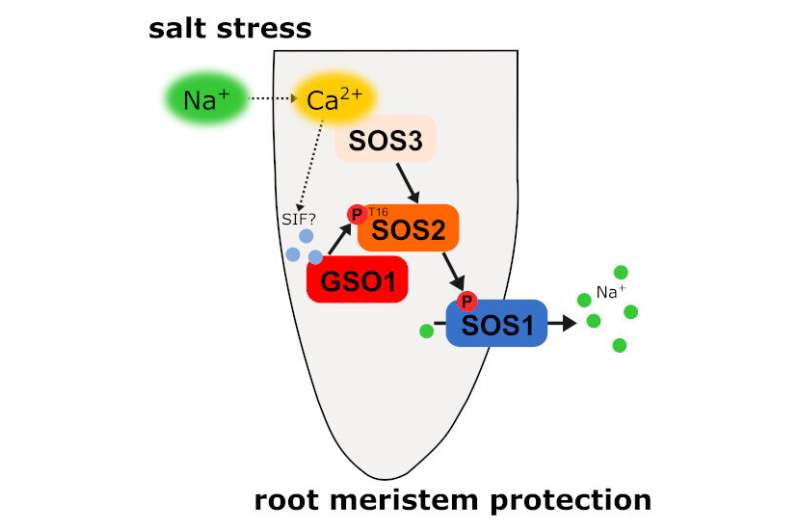This article has been reviewed according to Science X's editorial process and policies. Editors have highlighted the following attributes while ensuring the content's credibility:
fact-checked
peer-reviewed publication
proofread
Newly discovered signaling pathway protects stem cells in plant roots from salt stress

A team of researchers, including Prof Jörg Kudla from the Institute of the Biology and Biotechnology of Plants at Münster University, has found a mechanism in thale cress (Arabidopsis thaliana) that enables plants to provide protection against salt stress for their sensitive stem cells in the meristem at the root tip.
A high content of sodium-containing salts in the soil is a problem for many plants: as a result, they grow less well, or not at all. Soil salinization is seen as one of the greatest threats to feeding the world's population because it makes soils increasingly infertile, especially in dry regions.
A team of Chinese, German and Spanish researchers, including Prof Jörg Kudla and his team from the University of Münster, has now found a mechanism in thale cress (Arabidopsis thaliana) that enables plants to provide protection against salt stress for their sensitive stem cells in the meristem at the root tip. The meristem, which ensures that the root constantly forms new cells and thus can grow, is particularly sensitive—in contrast to fully formed plant cells, its cells have no vacuole inside where harmful substances can be disposed of.
The discovery that plants can provide protection against toxic salt stress specifically for individual groups of cells came as something of a surprise to the researchers. Although it was already known that there are various mechanisms in plants that enable them to cope with high salt contents in soil water—one is an active transportation of salt out of the cells, another is the mechanical impregnation of a specific cell layer in the root—what was not known was that plants also specifically protect the stem cells in their roots.
"The signaling pathway we have discovered—which combines components of known salt-stress signaling pathways with signaling proteins for the purpose of controlling root development—serves the additional purpose of specifically detoxifying the plant," says Jörg Kudla.
The mechanism includes a special enzyme—a receptor-like kinase called GSO1—that transports the sodium out of the cells of the meristem. To this end, GSO1 activates the kinase SOS2 (SOS stands for "salt overly sensitive"), and this in turn activates a transport protein (SOS1) that pumps sodium ions outward, via the cell membrane, and, in return, transports protons into the cell. In the case of salt stress, there is an increased formation of GSO1 especially in the meristem cells.
In addition, the team demonstrated that GSO1 also helps to prevent too much salt from penetrating into the vascular tissue of the root. This vascular tissue is located in the interior of the plant and transports water and minerals from the roots into the leaves. A mechanical barrier, the Casparian strip, is protected from minerals dissolved in the soil water penetrating into it in an uncontrolled fashion. The researchers also demonstrated a higher GSO1 content in the cells forming the Casparian strip increases due to salt stress.
"GSO1 is a receptor kinase well known in plant developmental biology," says Jörg Kudla. "It plays an important role in various stages in a plant's development. Now, for the first time, we were able to demonstrate that it also plays a role in salt tolerance and activates the 'sodium-out pump' via an alternative signaling pathway which is presumably not dependent on calcium." Calcium signals in the cells play a key role in other known adaptive responses of plants to salt stress.
The team discovered the significance of GSO1 by comparing numerous mutants of various receptor-like kinases in the thale cress. By studying protein interactions, they identified the reaction partners of the enzyme within the signaling pathways for protecting the meristem and forming the Casparian strip. Methods used in further investigations included mass spectrometry and high-resolution microscopy. The findings are published in The EMBO Journal.
More information: Changxi Chen et al, A salt stress‐activated GSO1‐SOS2‐SOS1 module protects the Arabidopsis root stem cell niche by enhancing sodium ion extrusion, The EMBO Journal (2023). DOI: 10.15252/embj.2022113004
Journal information: EMBO Journal
Provided by Westfälische Wilhelms-Universität Münster





















